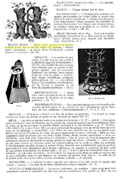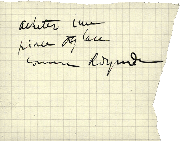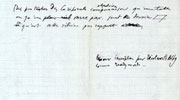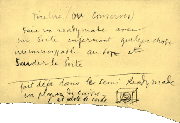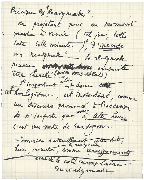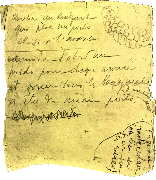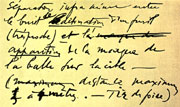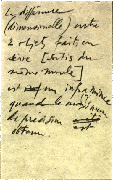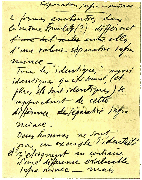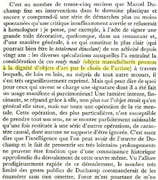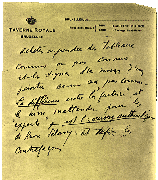|
The Unfindable Readymade by Hector Obalk |
|||||||||||||||||||||||||||||||||||||||||||||||||||||||||||||||||||||||||||||||||||||||||||||||||||||||||||||||||||||||||||||||||||||||||||||||||||||||||||||||||||||||||||||||||||||||||||||||||||||||||||||||||||||||||||||||||||||||||||||||
|
The following is part of a lecture, directly written in English, that was first given at the Conference of The College Art Association, Boston, MA, February 21-24, 1996. The lecture was presented in a session directed by Francis M. Naumann called "Marcel Duchamp and the Ready-made: From Origin to Consequence." The author is begging indulgence to the reader for his fancy English.
chapter 1. The traditional definition of a readymade The only definition of "readymade" published under the name of Marcel Duchamp ("MD" to be precise) stays in Breton and Eluard's Dictionnaire abrégé du Surréalisme: "an ordinary object elevated to the dignity of a work of art by the mere choice of an artist." (Figure 1)If you accept a readymade as an artwork, it means that you assume that the diverse traditional qualities of an artwork — such as contemplation, composition, manner, skill, style, expression, taste, beauty, etc. — suddenly become not relevant anymore. In other words, since readymade is art, the concept of art is completely revolutionized. That revolution has an author: Marcel Duchamp. And his historical and revolutionary readymades are all dated between 1913 and 1919. Such are in a few words the elements you can find in any recent history of art. It is on the base of this definition of readymades, that philosophers such as Dickie, Danto, de Duve, Genette and many others, have built a paragraph, a few pages, a chapter or the whole of their own esthetics theory. Let's now go back to the Duchampian artworks themselves.
chapter 2. The "not-assisted" readymades It is obvious that only a few readymades of Marcel Duchamp are concerned with this general and basic definition: those which are not physically "assisted" or "corrected" or "aided" or "imitated." For example Why not sneeze Rrose Sélavy?, which is a real construction, like a Dali's "objet à fonctionnement symbolique," is not a readymade. If a so-called readymade consists in the putting together of several objects, even very few, this assemblage would require after all solving a problem of composition, and thus, it is no longer a readymade. At least, it is no longer a readymade which revolutionizes the concept of art. Therefore, these readymades are to be rejected from our interest:
For the same reasons, all the readymades which have been corrected with pencil or with paint have to be rejected:
For the same reasons, the constructions which consist in reduced models of ordinary objects, such as windows, are also to be rejected:
Also, if the work consists in the transformation of a chosen object, it is not a readymade:
Even the famous air de Paris which cannot be reduced to the choice of a certain quantity of air, has to be rejected:
The only readymades we are interested in for this paper — not that the other readymades are not interesting (they are maybe more interesting artistically speaking, but not philosophically) — are pure objects resulting of a single choice. Traditionally, these "mere" readymades are:
Of course, we could still discuss the fact that these final readymades are not assisted in any way. The bike is vissé [screwed down] on a stool. All of theses readymades (except the restaurant fresco and the hat-rack) have very inventive (poetical or humorous) titles, all probably inscribed on the object. And some of them demand a very specific installation in the space: the hat-rack and the shovel hang from the ceiling, the coat rack is vissé on the floor, the urinal is reversed at 90º. (All these accessory details deserve a specific study, because much information is still missing.) But for the moment, I suggest to forget these details and to consider these ten readymades in spite of their literary titles and inscriptions, their installation in a space and the artistic context in which they could be shown. Under these conditions, it must be clear that there is, a priori, no physical difference between these readymades and the correspondent objects you could find in a shop. In other words, the difference does not appear if you consider the work physically (there is no work on a readymade), but only if you consider the artist's mind. Let us try to penetrate Duchamp's mind. intermediary question The first statements from the mouth of Marcel Duchamp concerning readymades are a bit late: in 1945 to Janis, and in 1955 to Sweeney. Indeed, you have only two ways of trying to penetrate the mind of Marcel Duchamp between 1913 and 1917, the time of these "not-assisted" readymades:
Let us begin with the story of the objects. chapter 3. The story of the objects If you carefully inspect the last and best chronology, established by J. Gough Cooper and J. Caumont (or Claude Rameil?), you notice that none of these ten readymades were exhibited for a long time (nearly twenty years), except for twice and under very peculiar conditions. The first time, it was in the Bourgeois Gallery, New York (Modern Art after Cézanne, 3 - 29 April 1916) under a reference in the catalogue ("No. 50, 2 Ready Mades"). We have no certainty about which were these "2 Ready Mades," but we know that they were placed in some kind of antechamber, perhaps in an umbrella stand, but not displayed in the real showroom of the gallery with a real label telling their title and author, as was done with the other works. The second time is the famous Fountain story, at The Society of Independent Artists, New York, 9 April - 6 May 1917. I won't argue about the fact that the piece was indeed not exhibited, as the rejection was not the will of the artist. The readymade object was actually proposed as an artwork, but not under the name of Marcel Duchamp, not even under the name of Rrose Sélavy: it was under the name of a non-existant guy called Richard Mutt. In fact, I am not arguing that Duchamp is not behind Mutt. But if a readymade is the conjunction, a "rendez-vous," between Marcel Duchamp and a chosen object, or more generally between the clear identity of an artist and the "mere choice of an object," I just want to point out that in the Bourgeois Gallery, the chosen objects were more or less hidden and that in the Independents' show the identity of the artist (whose name "Mutt" is very near "Mott," a trademark of urinals), was at least doubtful. So in both cases the "rendez-vous" was not clear. Then you have to wait till 1936 before the bottle rack is exhibited, in a Breton Parisian show at the Galerie Charles Ratton (22 - 31 May 1936), named Exposition Surréaliste d'objets mathématiques, naturels, trouvés et interprétés where the bottle rack was lying near some strange objects, which are also not regularly called art, such as: eggs, "christals containing millenary water," carnivore plants and scientific objects. But from that date, and especially from 1945, when historical retrospective exhibitions on Dada began to appear, replicas of Duchamp's readymades never stopped to be shown in numerous regular exhibitions at galleries and museums. Going back to the pioneer era of Marcel Duchamp's readymades (second half of the 1910's), let's consider again the Marcel Duchamp of that time. Here is a man
There is no doubt that this man obviously didn't want to exhibit his readymades at that time. My question is : Why?
chapter 4. The Notes Now let's see some Notes. Only two notes name directly a precise object to be good for readymades: a pair of ice-tongs and the Woolworth Building.
The three following notes don't name any object but describe the way these objects could be grasped and/or presented. In this note for example:
MD lets you know only the sound of the object. And, in order to be more complicated than the well-known With Hidden Noise [à bruit secret], he insists on the fact that this noise must be unrecognizable. The imagination of Marcel Duchamp is very fertile to invent difficulties, to install a subtle labyrinth between him (or you) and the ordinary object itself.
In the latter note, he only sets for himself the date (exact time) of the inscription of the object. Because the choice can be anything, it is the easiest thing to do, but also the most difficult thing to do on a metaphysical level: if you want this choice to remain "indifferent," without taste and without particular meaning.(1) You know the story of the Buridan ass who hesitates between a pot of oats and a pot of water, and finally dies of hunger and thirst. To avoid this tragic "embarras du choix" (difficulty of chosing), Marcel Duchamp invents a situation of emergency according to which, at that precise date, he will have to "inscribe" the first thing which would come to the top of his mind and within hand reach. Here again, the creation, the talent, the imagination… of Marcel Duchamp is definitely not in the choice of the object (we don't even know which it is), but in the fancy screenplay of the process of this choice.
In this note now, which is one of my favorites, MD gives the object only its weight. It is very difficult to imagine an object through its weight. Not because the weight is more imprecise than the visual aspect, but because the weight is humanly less identifying. In philosophy, we call it a less salient property of an object. And, in the second paragraph, MD still puts the objects conceptually farther from us, by introducing some fuzziness on the weight of the readymades, by giving only an annual mathematical average of them. MD loves this progressive complication, because it makes the objects always less graspable and always more conceptual. You could tell me that MD nevertheless made three works for real in connection with each of these preceding three notes: With Hidden Noise which contains a secret object, the comb which is dated "day, hour, and minute," and the cage containing pieces of sugar which are made in marble and thus weigh incredibly more. Yes, but these works are precisely not readymade objects. The conclusion is: either the readymade is a speculation (like those in the notes), or it is not a readymade. If you are not convinced, let's go back to the note concerning the sound.
You will notice that he calls a readymade the object which wouldn't be recognizable by its sound. But he calls semi readymade the real object which could give a body to such a project. In other words: when you make known that you make a readymade, you make a semi-readymade — there is no other way. In both projects, the work is not a readymade, it is a handwritten note here, it is a "not readymade" sculpture there. My first conclusion is that, in the case of Marcel Duchamp, the readymade is never a work of art; it is only the subject matter of a work of art. Of course all these notes are excellent, and here again you have to admit that Duchamp's creation consists, in every case, in the way he presents, through the sound, through the weight, through the programmed date, the far existence of the chosen object. That is why Duchamp's works of art definitely don't consist in the reality and not even in the "good" choice of the object. A readymade is "une chose que l'on ne regarde même pas (...) qu'on regarde en tournant la tête." (2) It is as if the readymade was the hero of a fable, of a story, of a school hypothesis, of a speculation according to which "an ordinary object [could] become an artwork because of the mere choice of an artist." Moreover, the anthropomorphism of the readymade in the vocabulary of Marcel Duchamp goes also towards a kind of fiction character making: he imagines readymades that could be malade, malheureux, assisté or aidé as if they were handicapped human beings. Now, if you still claim that :
prove the existence of "readymades" as works of art, then you make the same philosophical error as confusing the existence of Madame de Récamier with the existence of the painting portraying Madame de Récamier. Confirmations of the preceding question (chapter 3) This principle according to which "a readymade is not a work of art for Duchamp, but the subject matter of some of his works" is the mere reason why the objects were not exhibited at this time. Moreover, it gives also a very satisfying explanation that almost all of them have been lost or destroyed :
It is relevant to notice that nine out of the ten original not-assisted readymades don't exist anymore, if you take into consideration that almost all of the other readymades have been carefully preserved (except for pliant de voyage), as well as his other more "regular" artworks (chocolate grinder paintings, small glasses, drafts for the Bride, etc). Intermediary question If a readymade is an object of speculation, then, why such speculations? What place do they take in Marcel Duchamp's life, thought and work? To understand this, you have to read again the posthumous notes concerning the "infrathin." The notes on infrathin, which appear probably in the late thirties, prolong Marcel's speculations on the readymades.
chapter 5. The infrathin What means infrathin? Marcel says, "On ne peut guère en donner que des exemples. C'est quelque chose qui échappe encore à nos définitions scientifiques." (3) It is now time to try to give a definition, even if this proposed definition is partial, and would merit a much longer development. "Infrathin" generally characterizes a thickness, a separation, a difference, an interval between two things. At first step, "infrathin" means "very, very, very thin." It could be "1/10e mm = 100 µ = minceur des papiers" as MD says in note MAT 11. But at this level, the concept means "infinitesimal," it is not new nor interesting. At a second step, "infrathin" characterizes any difference that you easily imagine but doesn't exist, like the thickness of a shadow: the shadow has no thickness, not even at an Angstroem's precision. At a third step, the most beautiful one, "infrathin" qualifies a distance or a difference you cannot perceive, but that you can only imagine. The best example to introduce you to this notion is this note:
You know that there is a certain duration between the detonation noise of the shot and the apparition of the hole in the target, but this duration is not perceptible. Marcel Duchamp is certainly not interested in finding the instruments with which you could physically perceive this separation through some new technology. What interests him is making you understand that it is just enough to imagine it. The more invisible this difference is, the greater is the infrathin dimension of it:
And it is true that the very very old philosophical questions about identity versus similarity, or about the existence of concepts versus the true singularity of individuals, must have been completely removed by the Industrial Age. Examples are very important in philosophy and the examples that the greatest philosophers — Duns Scotus, Plato, Occam, Hobbes, whoever — had in mind to discuss these matters could be faces, tables, pebbles or flowers. But all these objects, so similar could they be, remain very different to the naked eye. And the "argumency" was easy for Hobbes, for example, to demonstrate the irreducible singularity of single things by pointing out the difference between "even" 2 flowers of the same age and species. Confronted with mass-produced objects, such as packs of cigarettes or bottle racks, our notion of identity or our humanist notion of singularity is much more difficult and interesting to maintain. The following note confirms that MD had this in mind, even in a naive way:
In front of two identical bottle racks, you know that they are not the same because they are two, but you also know that you could be rapidly mistaken if you don't spot them together. You stick to coordinates in time and space to identify them, but you know how much these references are moving and unserviceable.
On the next day, a third bottle rack is presented to you, and you have an absolute doubt about its identity. Is it a third one? Or one of the first two? Now, is there a difference between a bottle rack and the very same bottle rack chosen by MD? No. There is no difference. Yes, there is an infrathin difference, which is invisible: it is his artistical intention. The difference lies in the brain fact of considering this bottle rack as an object of the Bazar de l'hôtel de ville and that one as a true artwork.But MD never made such statements, only Richard Mutt did. Probably MD would have found such a statement rather pompous and ridiculous; it is a fact that he always said the opposite ("c'est une œuvre d'art qui n'en est pas une"; "c'était simplement une distraction"; "c'est un objet qui n'est même pas une œuvre d'art"). He never even wrote that readymades "elevate an ordinary object to the dignity of a work by the mere choice of the artist." It doesn't sound like MD to talk about dignity of an artwork. Thanks to André Gervais, we now know this definition has been written by André Breton, because you get a very similar sentence in his 1935 famous article "Phare de la Mariée." (Figure 11) What MD was, on the contrary, highly interested in, was imagining such a situation, as a pure fiction, between two copies of an ordinary object in the privacy of his own studio or on the written speculations of his personal Notes.
Chapter 6. Back to a 1923 note Let us see now one of the last notes, probably dated 1923. [Incidentally, Claire Bustarret from the C.N.R.S. and I have been working on the analysis of the paper in order to determine a more accurate dating of the Notes of Marcel Duchamp.]
Let's suppose that the painting is a painting by Delacroix and the name of the "painter known or unknown" is named Durand. In this note, what work is Marcel Duchamp the author of? Certainly not the Delacroix painting. Nor the idea of exhibiting Durand as the author of a Delacroix. Much more subtly, his work is the difference between a painting which, in view of its "style," is a Delacroix and the same painting which, in view of its signature, is supposed to be a Durand. The difference between a Delacroix and a Durand is a Duchamp. Can you imagine a more infrathin difference? Or to be more complete, Duchamp is the author of Rrose Sélavy who is the author of Durand who is the author of a Delacroix as a readymade. With Marcel, it is always a question of heightening the degrees of a situation, by encircling with bigger circles the preceding circle of the situation. It is not a question of putting his name everywhere. When I look at this last note, I think there is composition, manner, skill, style, expression, taste, beauty, but also humour, game, profoundness and cleverness. It is fair enough to call it art. All Duchamp's art is here, in these two sentences, in the story they tell, in the way the words are put together, in the rhythm and in the ellipses, in the human coolness and a certain taste for games, and in the simplicity of syntax to say such complicated things. This note deals with the notion of readymade, but is definitely not a readymade. Because a readymade is not a work, it is a notion. If Marcel Duchamp's works have changed the concept of painting or literature or sculpture or fiction, they haven't changed at all the concept of art. I could stop my paper here with that conclusion, hoping to convince the audience that Duchamp is not a magician nor a swindler who transforms, as with a magic wand, an ordinary object into a wonderful artwork. He is a thinker who expresses himself artistically.
chapter 7. Back to the first readymades Let us go back to the real "readymades" before they were lost. We have photographs of them hanging in Duchamp's studio, we have letters to Suzanne dealing with them. But there is nothing public. Who cares? — Could you tell me. Duchamp could have painted canvases at the same time and never have exhibited them, without us having doubts that they were Duchamp's works. But, precisely, a painting exists from the fact that it has been painted. Not a readymade. A readymade has to carry some contextual details which say: "this is a readymade." If not, it is only a shovel decorating the studio of an eccentric Frenchman. It is not enough that MD bought a bottle rack without using it to dry up bottles. It is not enough that MD believes and makes believe that this bottle rack is a work of art (because any collector considers any of the weird things he gets and installs in his house for plastic reasons, as pure and marvellous artworks — such as keyholders, coffee grinders or advertising ceramic plates). MD also has to believe and make believe that he (and not the designer) became the author of these chosen objects. And the only way to do so is to exhibit clearly the chosen object in an art show amid other works of art and with the same status. Such an exhibition didn't take place. So if there is no work on the object (because it is only chosen), and if there is no exhibition of the chosen object, there is no readymade, and consequently there is no new artwork. It is like a knife without a blade, and to which the handle is missing.
Paris, February 1996
notes
|
|||||||||||||||||||||||||||||||||||||||||||||||||||||||||||||||||||||||||||||||||||||||||||||||||||||||||||||||||||||||||||||||||||||||||||||||||||||||||||||||||||||||||||||||||||||||||||||||||||||||||||||||||||||||||||||||||||||||||||||||
